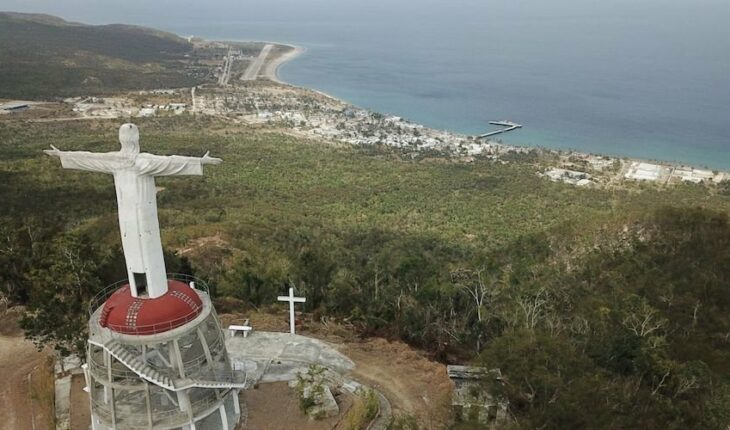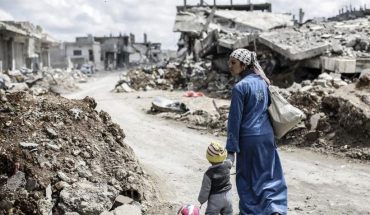Juan Francisco García arrived at the port of San Blas in 1971, when he was just over 20 years old. Among the mangrove forests, the canals overflowing with river crocodiles (Crocodylus acutus) and the breeding grounds of swamp mosquitoes, the now veteran environmentalist learned to circumvent the caciques of the place and to face economic interests that, since then, already established in that territory the shrimp farms, industrial agriculture and tourism.
The efforts of García and other activists were not enough to prevent that, in half a century, the jungles of this region of the country lost half of their extension and the mangroves only occupied two-thirds of the surface that he knew.
The member of the Mangrove Ecological Group warns of a new wave of projects planned for the San Blas-Matanchén region and the archipelago of the Islas Marías, south of the Gulf of California, in western Mexico. In particular, García is concerned about the work that, since 2020, has been carried out as part of the project to make the Islas Marías a center of tourist attraction.
The archipelago known as Islas Marías is located in the Pacific Ocean, about 120 kilometers from the coast of San Blas, in Nayarit. On Mother Island, the largest in the archipelago, the Mexican government maintained a penal colony from 1905 until March 2019, when President Andrés Manuel López Obrador announced the closure of the prison and a plan to transform the place as a recreational and cultural center.
Part of the complex that functioned as a penitentiary center and will now be a recreational and cultural center. Photo: Mexican government.
The current government’s plan is to make Mother Island a tourist spot that will begin receiving visitors in July 2022. For this, the Secretariat of the Navy – which will offer tourist packages, according to what was announced in April 2022 – will have three ferries that will depart from San Blas, in Nayarit, or from Mazatlan, Sinaloa.
The government is also contemplating carrying out works on the coast of Nayarit. For example, in Boca de Chila —between Vallarta and Tepic—, a naval sector and a tourist project of 80 hectares will be created that will have a hotel. A jetty will also be built to move to the Marias Islands.
As part of the tourism project in the Islas Marías, in the port of San Blas, in Nayarit, the dredging of canals has already been carried out to make possible the entry and exit of the ferries that will take tourists. In addition, works are being done to enter the town.
Dredging works in San Blas, Nayarit. Photo: Juan Francisco García.
Ignore a vulnerable environment
The three islands and the islet that shape the Islas Marías archipelago were declared a Biosphere Reserve in 2000. In addition, in 2005, they were designated a Natural Heritage of Humanity by the United Nations Educational, Scientific and Cultural Organization (UNESCO).
Due to its remoteness and its insular condition, the archipelago protects an important natural wealth: of the 387 vascular plants that have been registered in the place, ten are endemic. In addition, it has 27 species of reptiles and 13 species of land mammals, according to the AC Island Ecology and Conservation Group.
The Biosphere Reserve Management Program, published in 2021, states that the archipelago “should basically be considered as a conservation site, restricting tourist activities, limiting itself to hiking and guided tours only on Maria Madre Island.”
Islas Marías Biosphere Reserve. Photo: Jorge Castrejón/Conanp.
Read more | Mexico: Communities unite to boost tourism allied with forest conservation
That is why Juan Francisco García, a member of the Mangrove Ecological Group and the advisory board of the Islas Marías Biosphere Reserve, sent a letter addressed to President Andrés Manuel López Obrador, in which he points out that the presidential plan to make a recreational center on Isla Madre contradicts what the management program indicates. So far, he has had no response.
Francisco García mentions that the promotion of agricultural, aquaculture and tourism projects that have been imposed without considering the fragile ecosystems of the region have caused the loss and decrease of important ecosystems. Several studies prove the environmentalist right.
Loss of forest and mangroves
In the report Mangroves of Mexico published in 2021 by the Commission for Knowledge and Use of Biodiversity (Conabio), Nayarit appears as one of the three states in the country that register a decrease in the extension of that ecosystem. Since 1970, the state has run out of 11,000 hectares of mangroves. This has happened, despite the fact that the legislationThe Mexican government explicitly prohibits, in Article 60 Ter of the General Wildlife Law, mangrove logging.
Mangrove area in La Tovara, San Blas.
In addition, two investigations on the San Blas area show the loss of low and medium forest in the region. The first of the studies is entitled “Evaluation of changes in the landscape and their effects on the coastal wetlands of the estuarine system of San Blas, Nayarit”. In this work, researchers César Berlanga-Robles and Arturo Ruiz-Luna, from the Center for Research in Food and Development of Mazatlan and the UNAM, respectively, point out that in 1973, the low and medium forest extended over 15,040 hectares, but by 1992 there was only half: 7829 hectares.
The cause of the greatest loss of low- and medium-sized forests is agriculture. In the case of mangroves, the damage is caused by shrimp farms.
In another research, “Change of cover and land use in the coastal plain associated with anthropogenic processes: San Blas case, Nayarit”, researchers from the University of Guadalajara and the Autonomous University of Nayarit reviewed satellite images between 2000 and 2019, of the Ramsar San Blas-La Tovara site. Their data show that in that period of time the mangroves in the area lost just over 2,000 hectares; that is, almost 28% of its original coverage.
If the loss continues at that rate, the researchers warn that by 2038 there will be just over a thousand hectares less mangroves.
Port of San Blas, Nayarit.
What is the value of 2103 hectares of mangrove lost between 1973 and 2019? Ernesto Bolado, spokesman for the civil organization SuMar, explains that each hectare of mangrove in the region has an annual value of 53,425 dollars (almost 1.1 million Mexican pesos). This figure includes aspects such as food production ($37,500); regulation of environmental disturbances, such as hurricanes or avalanches ($8240); waste treatment ($6696); recreation ($658); refuge and habitat of species ($169) and miscellaneous products ($162).
This means an annual loss of more than 112 million dollars, or about 2200 million Mexican pesos, which impact on the economy and quality of life in the region.
Juan Francisco García assures that the coast of Nayarit is one of the most affected by the displacement of the sea, because the marshes that border a good part of the coastline, have become unstable with projects such as the Aguamilpa hydroelectric plant (1990), the increasingly wide roads -such as the one that connects San Blas with Tepic- and works that have been retaken such as the Centenario channel, for irrigation of the coastal plains of Nayarit.
Entrance to the Recreational and Cultural Center of the Marias Islands. Photo: Government of Mexico.
Read more | Mexico: Camera Trap Investigation Reveals State of Ocelot Population in Tamaulipas
The studies cited show that the erosive effect of the sea has displaced emerged lands in San Blas. Between 2000 and 2019, maps from research that focused on the San Blas-La Tovara Ramsar site reveal that there are 359 hectares less land area.
Researcher Exequiel Ezcurra of the University of California, Riverside, one of Mexico’s most renowned ecologists, attributes it to the combination of mismanagement, environmental destruction and climate change that gradually raises sea levels. “The case of the coast of Nayarit is not an apocalyptic prophecy, it is something that we are already seeing in a very notorious way,” he warns in an interview.
Damage to the archipelago
For more than a century, the Marias Islands were famous for housing the penitentiary. The infrastructure that was built on site for the prison to operate caused severe damage to the ecosystems and environmental services of the archipelago.
The biologist Armando Calderón Rodríguez, who until 2021 worked in the National Commission of Protected Natural Areas (Conanp), lists some impacts already accumulated by the long history of the penitentiary nucleus: “Since the 80s, María Madre Island already presented water stress. Things got worse in 2010, when its population increased to eight thousand people.” As an effect, the tropical deciduous and subdeciduous forest declined in the northern part of the island, which, in addition, registers a high impact of livestock and introduced species, from rats and cats to cattle.
The blue-footed booby bird is present in the Marias Islands. Photo: Conanp.
Domestic cats and the black rat, for example, are the main causes of the decline in populations of reptiles, mammals and native birds. This has led to the probable extinction of two endemic mammals, the rice mouse. (Oryzomys nelsoni) and the mouse of the Marias Islands (Peromyscus madrensis), as well as the loss of the marsupial mouse (Tlacuatzin canescens). Other native species, such as the boa, iguana and hawksbill turtle are under high pressure.
“When the end of the penitentiary was announced, experts pointed out the need for the place to have a break to recover the water tables and the forest. Many trees no longer gave seeds due to the extreme dryness of the environment, they were stressed, and that is why a nursery of native species was established,” explains Calderón Rodríguez.
The penitentiary closed between February and March 2019. The recommendation of the experts was not heeded: immediately, the remodeling of the place began to transform it into a recreational center.
Mongabay Latam requested an interview with the authorities of the National Commission of Natural Protected Areas (Conanp), but there was no response.
One of the areas of the recreational and cultural center Islas Marías. Photo: Government of Mexico.
In the old port of San Blas, founded in the sixteenth century, Juan Francisco García fears that if the tourist explosion sought by the Mexican government in the region succeeds, urban services will collapse, the mangrove area will be further damaged and new businesses will be sought at the expense of that fragile ecosystem.
One of the material obstacles that have driven away big business since the port entered its long decline, is the multiplication of swamp flies or gnats in the adjoining estuary of La Tovara. Environmentalists use the mosquito as a symbol of resistance to extractive projects, to the extent that they stamp them on white T-shirts to link them to environmentalism.
“Until now, those tiny but incisive and annoying insects have defended us,” says Juan García convincedly. This time, will mosquitoes prevent the imposition of projects that sacrifice ecosystems? “I don’t know, don’t dismiss it… it’s always been like this.”
What we do at Animal Político requires professional journalists, teamwork, dialogue with readers and something very important: independence. You can help us keep going. Be part of the team.
Subscribe to Animal Político, receive benefits and support free journalism.#YoSoyAnimal





